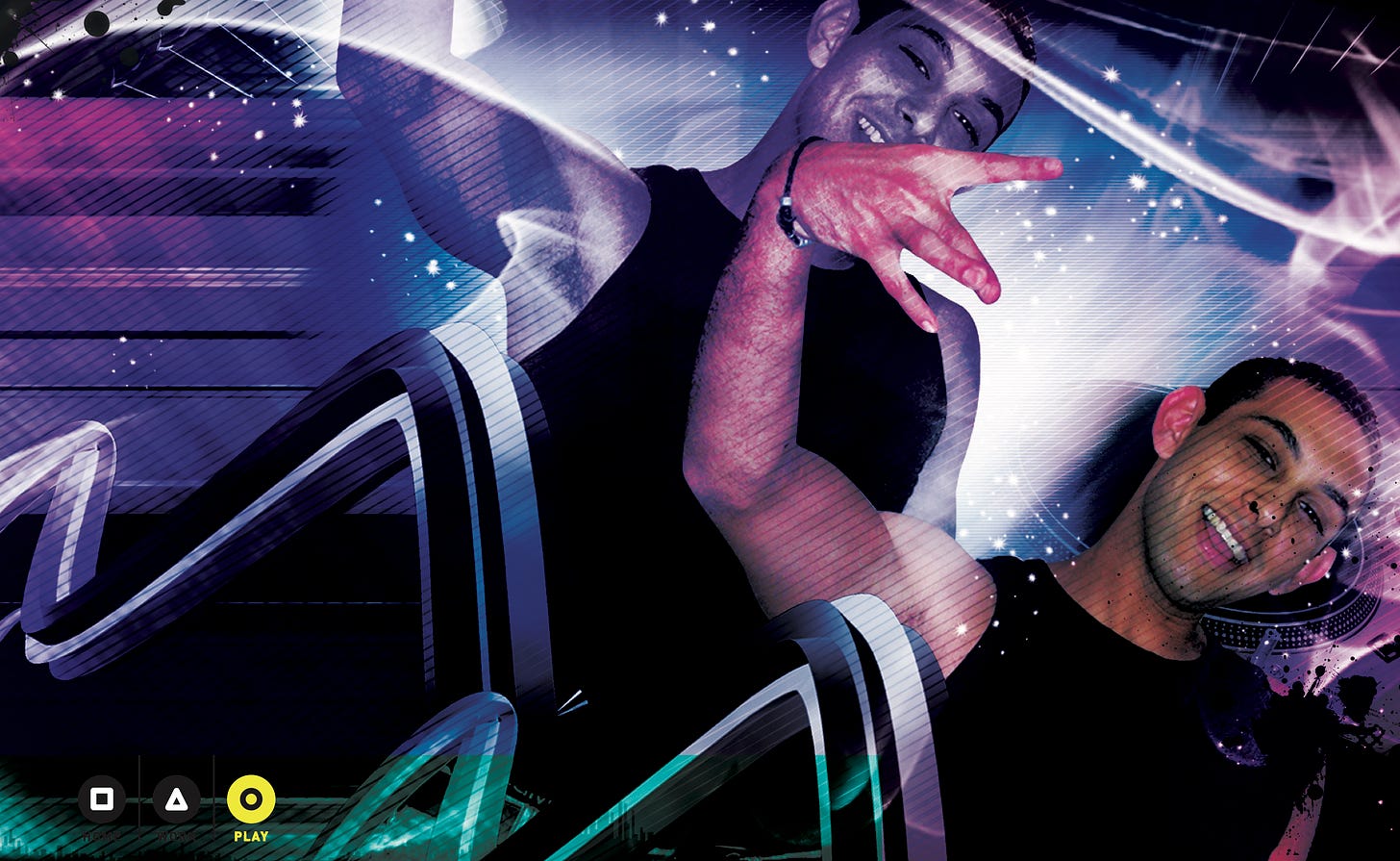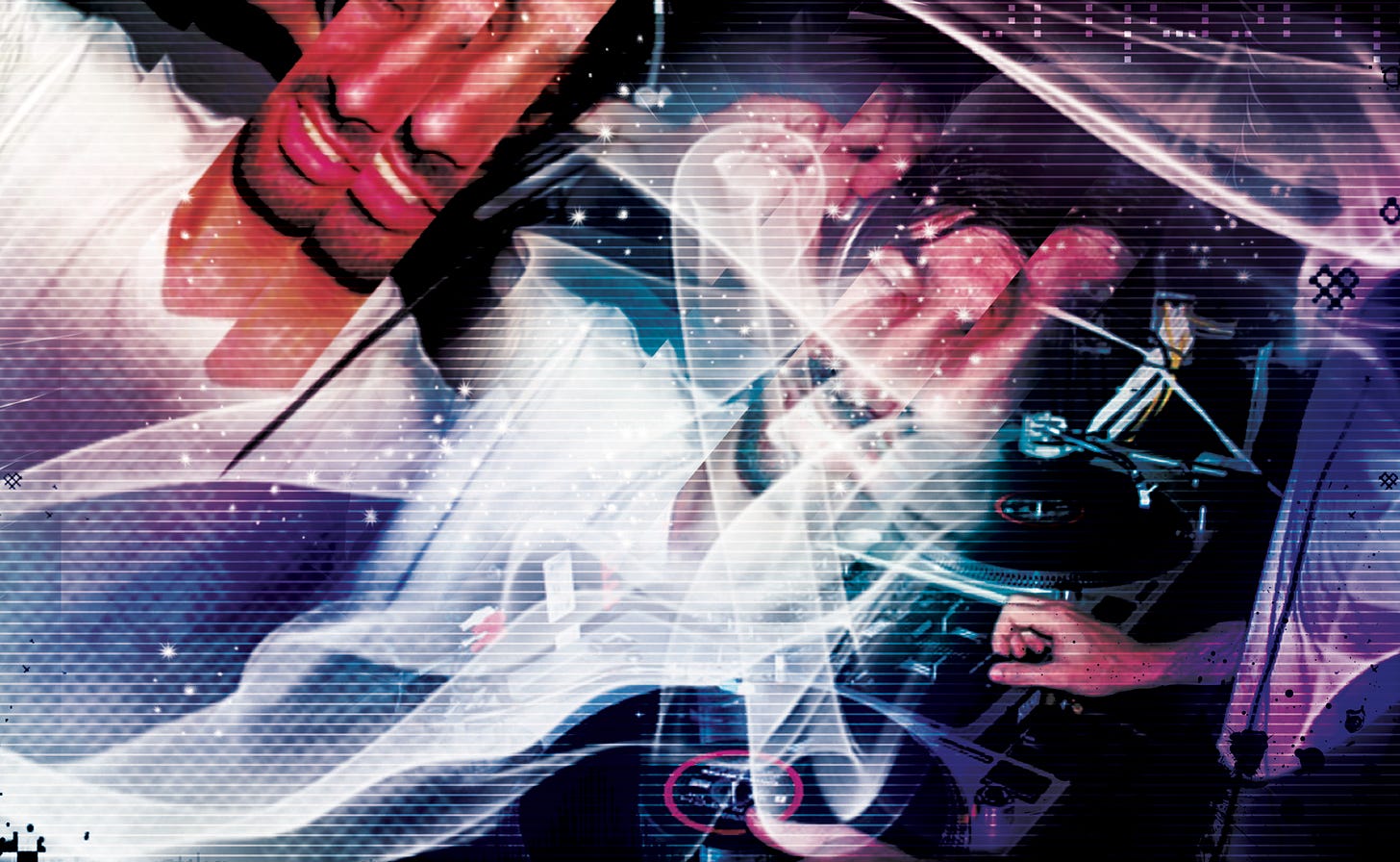Back to the Warehouse: Two Generations of Promoters on the DIY Spirit of Rave
In 2007, we asked legendary LA underground promoter Mr. Kool-Aide (aka Stephen Haupfner) and relative new schooler Mo Samad their thoughts on the challenges of creating the perfect event
Originally published in the “DIY” Issue No. 149, Sep/Oct 2007. Edited for clarity.
By Nicole Powers
Illustrations by Jeremy Lindenmeir
With more permits and fewer fliers, the DIY spirit of rave lives on in Los Angeles. Promoters from two generations compare today to back in the day.
At Age 15, Stephen Haupfner started throwing raves before that four-letter word was even invented. Known as DJ Kool-Aide, at the height of his early-’90s career, Haupfner’s “underground” parties attracted crowds of 30,000 people. He has since parlayed his renegade ways into a successful career, throwing events for corporate clients such as Ridley Scott, Hugo Boss, and Jaguar while keeping one foot in the underground with his mini-warehouse events in Downtown LA. Mo Samad, the owner of IT Promotions, throws raves today—complete with sci-fi fliers and hardcore rooms—that can still attract crowds of up to 10,000. We thought bringing these two generations of rave promoters together would shed some light on throwing your own party 15 years after the rave explosion.
URB: When you both started out, it was possible to throw parties in a very underground, unpermitted way, which isn’t so open to people now. What are your thoughts on the climate today?
Mo Samad: I think it’s harder. I think you have to have more money now.
Stephen Haupfner: It’s kind of the opposite, to tell you the truth. When you have huge events going on that are such high dollars and high production, that’s what creates the underground. That opens the door for someone to come in and do something that’s really lowkey and smaller.
So what would you do if you had to start out now?
SH: I wouldn’t even know. We do parties now, but we have fire marshals; we have ABC [Alcoholic Beverage Control] permits, everything. It’s not remotely worthwhile doing anything that’s illegal just for my own reputation.
MS: If you’re doing a show that’s going to pull 3,000 or 30,000 people, it is a big responsibility. I think it’s better to do it a bit safer and pay a little bit more.
Because legitimate promotion is more complex these days, would you recommend working for more experienced promoters to learn the ropes?
SH: I do, yes.
MS: If I had somebody tell me not to do a few little things here and there, it would have saved me a lot of money, a lot of heartache. I think with the underground, you have more risks, and when it comes to business, less risk is better.
What are the biggest lessons you’ve learned along the way?
SH: There were no rules when we started out. There was no one doing what we were doing before us, so by default, what we were doing became the definition of what you’re supposed to do. So everyone who came after followed what we were doing—good or bad. They’re still doing it, so I guess, in some respects, it was fairly good. You’ve got to start with basic things like how much money you have. What do you have to work with? And if you can only do a party for 400 or 500 people, well, then that’s what you can afford.
MS: You have to lose money. You’ve got to hurt a little bit so you learn.
Going back to the basics, what are the first things you take care of?
MS: The first thing is always the venue. After that, you’re working with budget, talent, and production. But I would say the major thing would have to be the venue.
What are the rules of thumb for your budget?
SH: It depends on the event. If you don’t have your own following, then you have to spend more on talent. If there’s someone brand new, they’re going to have to spend a lot of money on talent. But the irony is then they’re creating something that’s only based on the talent, so they’ve got to do something to make people believe in a name, too. It sounds cheesy, but you have to brand something that people identify with. You have to build a reputation.
MS: Every show you do, you have to better it. That’s the way I look at it.
What promotional tools are you using? Have things gone paperless yet?
SH: To be honest, I’m just learning the Internet aspect of promotion, and it helps a lot.
MS: I haven’t created a flier in seven or eight years. It’s email. Especially in the last year or two, it’s blogs and MySpace. It’s so instantaneous. I have friends that have never played anywhere but my parties, and they’re getting flown to Australia because someone put them on their blog.
How do you know if people will come?
SH: When we were doing huge events, we’d gauge how the pre-sales were going. If we have 10,000 pre-sales, we’d figure there’d be 15- to 20,000 people showing up.
MS: If I pre-sell 100 tickets, I’ll get about 1,000 people. On fliers, we do the same thing. It’s 10 percent.
SH: If you hand out fifty thousand fliers, you should get 5,000 people. It got kind of ridiculous at the end. We were printing up to 300,000 fliers. We just said there’s got to be some better way to do it because it’s just a heinous amount of crap on the ground. It’s so horrible for so many different reasons.
So a better way is through email lists?
SH: Yes. I mean, we scaled right down. We’re not doing 30,000 people.
MS: What do you pull with your email lists?
SH: It depends on the event. I have eight different lists that are all broken up into different categories. If I do a huge event, I’ll send out everything. If I’m doing a smaller thing, I’ll send out to specific lists. But we usually get about 75 percent of our list, in the sense of if I have 2,000 people RSVP, they’ll probably be about 1,500 people that show up.
If you get 2,000 people to RSVP, how many people are you emailing out to?
SH: The majority of my list, which I would guess is somewhere around 15- to 20,000. But those 2,000 people don’t pay to get in. It’s all guest list; RSVP only. It’s strictly a private event.
Then how are you making money?
SH: Off the bar.
MS: We go for ticket sales and water sales. If you pull a crowd of 4,000 people, you can make a good amount just off the water. But ticket sales are primarily where we make our money.
Where do you see the future going?
MS: We’re trying to keep it to a couple of big shows a year. We’re trying to do a club right now, as well. We did a fundraiser in 2001 that we’re trying to bring back, too.
SH: You know, there’s the whole new-rave tag, which is ironic in so many different ways. But we are ramping up to do bigger things again. It just depends on how it goes. Whether it’s fun or not will really determine how far we go with it.
Writer, editor, photographer, videographer, social media consultant, and tactivist (tactical activist) Nicole Powers uses art and technology to share ideas that make the world a better place.






